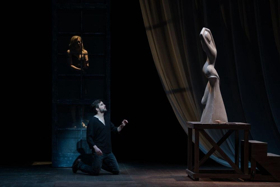Review: PIGMALIONE/PIGMALION at City Opera Not Lover-ly Enough

and statue. Photo: Sarah Shatz
There's no 'Enry 'Iggins or 'Liza Doolittle in Donizetti's IL PIGMALIONE or Rameau's PIGMALION--we'll have to wait for Lincoln Center Theatre's MY FAIR LADY revival (based on Shaw's PYGMALION) next month for that. But this pair of oddities, produced by New York City Opera last weekend at the Gerald Lynch Theatre, gave us the chance to see how the legend of the man who fell in love with a statue and brought it to life was handled by a pair of major composers--if not proving their neglect has been unwarranted.
First on the bill was the Donizetti: a one-act scena lyrica that's really an extended monologue for the sculptor, Pigmalione (tenor Piotr Buszewski), with a short-but-sweet aria from the statue who comes to life as the fair Galatea (soprano Jessica Sandridge). The composer of LUCIA DI LAMMERMOOR, the Tudor Trilogy and L'ELISIR D'AMORE, among 60+ other operas, wrote this as a 19-year-old student at the Bologna Academy in 1816.
It's uncertain whether the piece was performed in his lifetime and City Opera General Director Michael Capasso announced before the performance that this was the US premiere. One thing seems clear from its first notes: Donizetti undoubtedly emerged from his mother's womb sounding like Donizetti. Even though he wouldn't have his first success for many years, you can hear the tonality and style, if not the sophistication, that we know from his most famous works.
Tenor Buszewski, making his US debut with the City Opera performances, gave an ardent performance of the composer's soaring--if not particularly varied--lines, the intensity giving us a preview of the composer's mad scenes to come. It will be interesting to hear him again in one of the composer's more mature works. When soprano Sandridge finally made her appearance as the statue come to life, her lovely, sweet voice provided a good contrast to the tenor's. The simple, modern setting by John Farrell, moody lighting of Susan Roth and costumes by Janet O'Neill were just right.
The second half of the program was PIGMALION written by Frenchman Jean-Philippe Rameau in the mid-18th century, when the Pygmalion myth from Ovid was extremely popular. This was another one-acter, but with ballet thrown in for good measure and, frankly, providing the best part of the piece. Farrell and O'Neill provided a smart, 18th-century look to the opera, and Georgianna Eberhard's wigs were just right.
I've admired the work of tenor Thor Arbjornsson in Rossini--LoftOpera's COMTE ORY and OTELLO--but he found the style of this French work not particularly congenial to his voice and seemed strained by it. Soprano Samarie Alicea, on the other hand, seemed much at home in both the singing and dancing of the Statue, while mezzo Melanie Long was fine as Cupid.
Director/choreographer Richard Stafford kept things moving along nicely, particularly in the Rameau, where he had some fun with the statues/dancers and party guests, as they took turns at coming to life. Gil Rose and the City Opera Orchestra seemed more at home with the Donizetti, but in general provided the necessary momentum for the two works to proceed apace.
Reader Reviews

Videos

